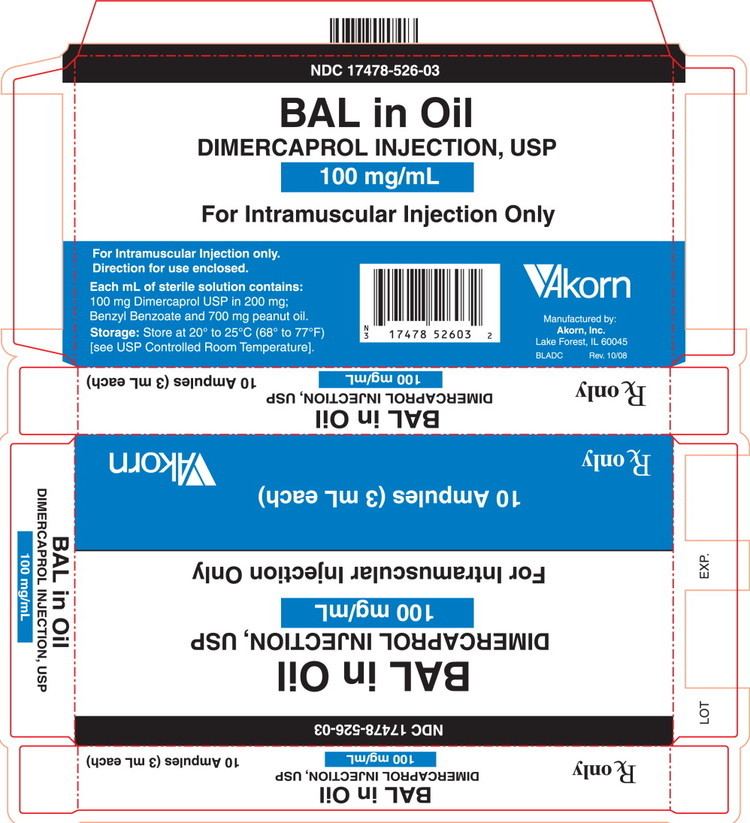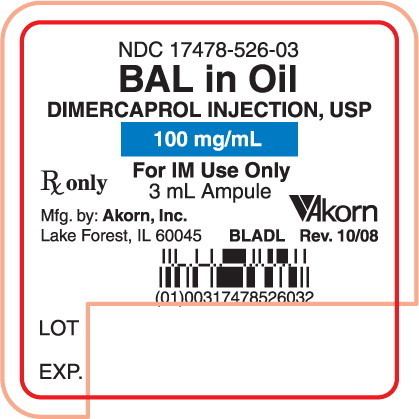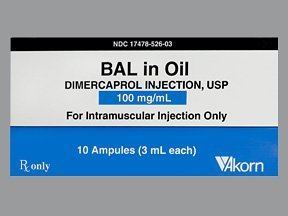Trade names BAL in Oil ATC code V03AB09 (WHO) | AHFS/Drugs.com Monograph Routes ofadministration intramuscular CAS ID 59-52-9 | |
 | ||
Pregnancycategory US: C (Risk not ruled out) | ||
Dimercaprol, also called British anti-Lewisite (BAL), is a medication used to treat acute poisoning by arsenic, mercury, gold, and lead. May also be used for antimony, thallium, or bismuth poisoning but the evidence is not good for these uses. It is given by injection into a muscle.
Contents

Common side effects include high blood pressure, pain at the site of injection, vomiting, and fever. It is not recommended in people with peanut allergies. It is unclear if use in pregnancy is safe for the baby. Dimercaprol works by binding with heavy metals.

Dimercaprol was first made during World War II. It is on the World Health Organization's List of Essential Medicines, the most effective and safe medicines needed in a health system. In the United States a course of treatment costs more than 200 USD.

Medical uses

Dimercaprol has long been the mainstay of chelation therapy for lead or arsenic poisoning, and it remains an essential drug. Nonetheless, because it can have serious adverse effects, researchers have also pursued development of less toxic analogues.
Mechanism of action
Arsenic and some other heavy metals act by chemically reacting with adjacent thiol residues on metabolic enzymes, creating a chelate complex that inhibits the affected enzyme's activity. Dimercaprol competes with the thiol groups for binding the metal ion, which is then excreted in the urine.

Dimercaprol is itself toxic, with a narrow therapeutic range and a tendency to concentrate arsenic in some organs. Other drawbacks include the need to administer it by painful intramuscular injection. Serious side effects include nephrotoxicity and hypertension.

Dimercaprol has been found to form stable chelates in vivo with many other metals including inorganic mercury, antimony, bismuth, cadmium, chromium, cobalt, gold, and nickel. However, it is not necessarily the treatment of choice for toxicity to these metals. Dimercaprol has been used as an adjunct in the treatment of the acute encephalopathy of lead toxicity. It is a potentially toxic drug, and its use may be accompanied by multiple side effects. Although treatment with dimercaprol will increase the excretion of cadmium, there is a concomitant increase in renal cadmium concentration, so that its use in case of cadmium toxicity is to be avoided. It does, however, remove inorganic mercury from the kidneys; but is not useful in the treatment of alkylmercury or phenyl mercury toxicity. Dimercaprol also enhances the toxicity of selenium and tellurium, so it is not to be used to remove these elements from the body.
History

Its original name reflects its origins as a compound secretly developed by British biochemists at Oxford University during World War II as an antidote for lewisite, a now-obsolete arsenic-based chemical warfare agent.



